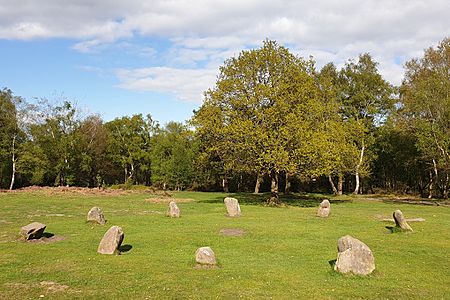Scheduled monuments in Derbyshire facts for kids

Did you know that the English county of Derbyshire is home to over 500 special historical places called Scheduled Monuments? These are like super important historical sites or old buildings that the government wants to protect.
Contents
What Are Scheduled Monuments?
A Scheduled Monument is a really important archaeological site or historic building in the United Kingdom. These places are so special that they get extra protection from the government. This means no one can change them without permission.
Why Are They Protected?
These sites are put on a special list, or "schedule," by the Secretary of State for Culture, Media and Sport. This person is a government official in charge of culture and sports. The main goal is to keep these historical places safe for everyone to learn from and enjoy for many years.
Who Looks After Them?
The job of finding and protecting these sites mostly falls to an organization called English Heritage. They are experts at looking after England's historic places. There are about 20,000 Scheduled Monuments across the UK. English Heritage keeps track of all of them.
Laws That Protect History
The rules for Scheduled Monuments come from two important laws: the Ancient Monuments and Archaeological Areas Act 1979 and the National Heritage Act 1983. These laws help make sure our history is preserved. Sometimes, these sites are also called scheduled ancient monuments.
Scheduled vs. Listed
Sometimes, an old building might be both a Scheduled Monument and a listed building. Being a listed building is another way to protect old structures. However, English Heritage often thinks that listed building status is a better way to protect buildings. If a monument is no longer considered important enough for this special protection, it can be "descheduled." This means it's taken off the list.
Derbyshire's Amazing Monuments
Derbyshire has more than 500 of these incredible Scheduled Monuments! They include all sorts of interesting places. You can find ancient stone cairns, which are piles of stones, and mysterious stone circles. There are also old burial mounds called barrows.
What Else Can You Find?
Derbyshire's monuments also include relics from old lead mining, showing how people used to get valuable metals from the ground. You can also see ancient settlements where people lived long ago. Plus, there are more than 20 historic bridges that are protected.
Exploring Derbyshire's History
Because there are so many Scheduled Monuments in Derbyshire, they are organized into separate lists for each area, or district. This makes it easier to find out about the history in different parts of the county.
- Scheduled monuments in Amber Valley
- Scheduled monuments in Bolsover
- Scheduled monuments in Chesterfield
- Scheduled monuments in Derby
- Scheduled monuments in Derbyshire Dales
- Scheduled monuments in the Borough of Erewash
- Scheduled monuments in High Peak
- Scheduled monuments in North East Derbyshire
- Scheduled monuments in South Derbyshire

